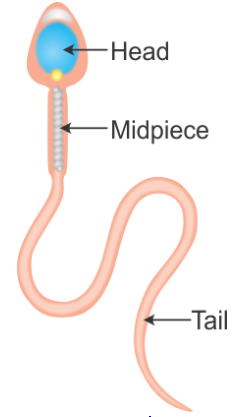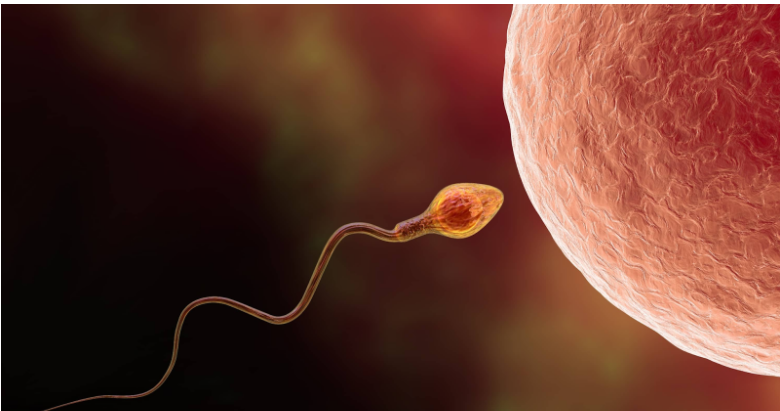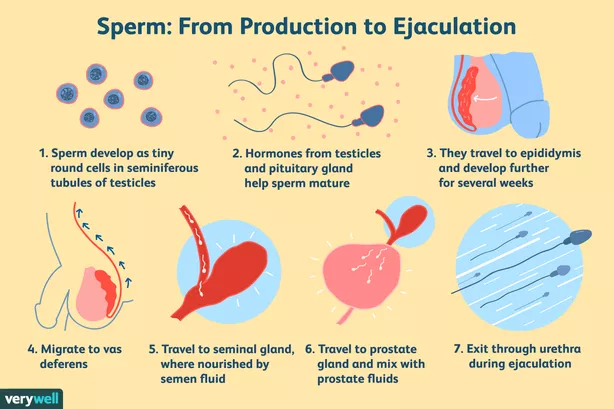Sperm Study Guide
Introduction
Sperm is another name for spermatozoon, and its plural form is spermatozoa which is the male reproductive cell produced by humans and most animals. These sperms are produced in the male testes, which produces new offspring when released in the female part.
Structure of Sperm
Under microscopic observation, it is found by researchers and scientists that sperm comprises three parts. The diagram of the sperm in this guide further helps to visualize these parts.
The head
- The tip of the sperm is called the head of the sperm, and it is found to contain chromatin, which is the DNA matter that makes up the chromosomes.
- It is noted that both the human sperm cell and human egg cell comprise 23 chromosomes.
- The combination of the sperm with the egg results in the formation of the embryo, which includes 46 chromosomes.
- The headcover of the sperm is termed an acrosome. The acrosomes contain proteins helping the sperm to pierce the outer shell of the existing egg.
- The head of the sperm is all nucleus which is firmly compacted into a small elliptical shape roughly 4-5 m long and 2.5 to 3 m wide.
The midsection
- The part which follows the head is called the midsection, which holds energy forming mitochondria.
- These are the unique structures of sperm that provide energy to sperm cells which facilitate their movement.
The tail
- The midsection is followed by the sperm tail, also known as the flagellum, which allows movement.
- The tail sets the forward motion of sperm towards an egg for fertilization.

Where is sperm produced?
- The male reproductive organs known as testicles are accountable for making sperm.
- A sex hormone known as testosterone, which determines male characteristics, is also produced by testicles.
- Testosterone plays a vital role in sperm production and plays a major role in a sex drive of a person.
- The production of red blood cells is also affected by testosterone levels. Bone and muscle mass are also affected along with fat storage in men.
- The process of producing sperms is called spermatogenesis. This activity starts in the seminiferous tubules inside the testicles.
- These tubules are capable of producing sperm cells known as spermatocytes.
- To become spermatids, the spermatocytes go through a series of divisions.
- Spermatids are young sperm that must grow and mature until they become sperm cells.
- It is observed that a male body takes nearly 74 days to process for the production of new sperm cells, but the duration may differ from person to person.
Life of sperm
Studies reveal that an average man may produce roughly 70 to 75 million sperm cells per milliliter of ejaculate. After the ejaculation, the sperm may live up to 5 days in the female vagina. A human embryo is formed when the sperm unites with a female gamete, commonly known as an “egg.”
Sperm and Male Fertility
There are two deciding elements regarding fertility in men, the first being the sperm count and the second being the sperm motility.
Sperm Count
Millions of sperm are produced by testicles each day, varying from person to person. Studies suggest that the size of testicles has no role in producing perms each day. However, it is observed that sperm production may be different for people having different ethnicities.The study suggests that the average daily sperm production levels for men of the following ethnicities :
- Hispanic: between 225 million to 400 million per day
- White: between 180 million to 325 million sperms per day.
- Black or African: 100 million to 150 million sperms per day.
- Chinese: between 75 million to 150 million sperms per day.
- Asian: between 100 million to 200 million sperms per day.
Sperm Motility
The potential of sperm to move towards an egg is called sperm motility. Sperm motility is pivotal in fertilizing an egg. The egg does not contain cells that may facilitate movement, so it is left for the sperm to propel themselves towards the egg.
Causes of Male Infertility
Assessment of semen provides essential reports in connection with sperm count, semen volume, sperm motility, concentration, and morphology.
- Some people have been found to have zero to low sperm present in their ejaculate. The less concentration of sperms does not mean that the testicles have stopped producing sperms.
- This condition is called azoospermia, can result in low sperm production caused by a blockage that hampers sperm delivery into the ejaculate.
- Many studies and researchers have revealed that about 80% of infertile men can produce sperm. However, the sperm may not be healthy enough or lack the motility to fertilize an egg.
- Age plays a significant role in the quality of sperm; it is observed that the quality of sperm decreases with aging.
- There are many other factors that directly or indirectly affect the quality of sperm, some of which are lazy or dormant lifestyle, using illegal drugs, excessive consumption of alcohol and smoking cigarettes are one of the main reasons of having a low sperm count in the modern age.
- Usin steroids and other such available supplements which aid in the development of muscles, is also one of the reasons to have low sperm count.
- Basic medical conditions such as heart diseases or heart problems, or any other cardiovascular diseases are also found to affect sperm count. Drastic lifestyle changes may help people improve their fertility.
Fertility Treatments
- Fertility treatments include techniques like intrauterine insemination and in-vitro fertilization, commonly known as IVF.
- The techniques in IUI involve directly placing the sperm into the female’s uterus to assist fertilization.
- In IVF, the sperm and egg are brought together in a laboratory, and the growing embryo is transferred into the uterus.
- For cryopreservation and sperm banking, the samples taken from a person are first monitored and tested before donation for any infections and genetic conditions.
- People facing fertility issues can benefit from semen analysis, and these tests help identify any problems related to sperm issues.
Conclusion:
- Sperm is the equivalent of a male gamete
- It fuses with the female gamete (the egg) to produce offspring
- Sperm is produced in the testicles through a process known as spermatogenesis
- Male fertility is dependent on sperm count and motility
- Sperm banks allow for solutions to infertility
FAQs:
1. How many sperms are required to make an egg fertilize?
Ans: It just takes one single sperm to make an egg fertilize out of more than 100 million sperm released by a man.
2. What happens if you forcefully try sperms to come out?
Ans: When we try forcefully to stop sperm from coming out, the body breaks down semen and completely reabsorb them.
We hope you enjoyed studying this lesson and learned something cool about Sperm! Join our Discord community to get any questions you may have answered and to engage with other students just like you! Don’t forget to download our App to experience our fun, VR classrooms – we promise, it makes studying much more fun!😎
Sources:
- Healthy sperm: Improving your fertility. https://www.mayoclinic.org/healthy-lifestyle/getting-pregnant/in-depth/fertility/art-20047584. Accessed 2 Dec, 2021.
- Sperm. https://www.britannica.com/science/sperm. Accessed 2 Dec, 2021.
- Sperm. https://flexbooks.ck12.org/cbook/ck-12-biology-flexbook-2.0/section/13.60/primary/lesson/human-sperm-bio/. Accessed 2 Dec, 2021.



